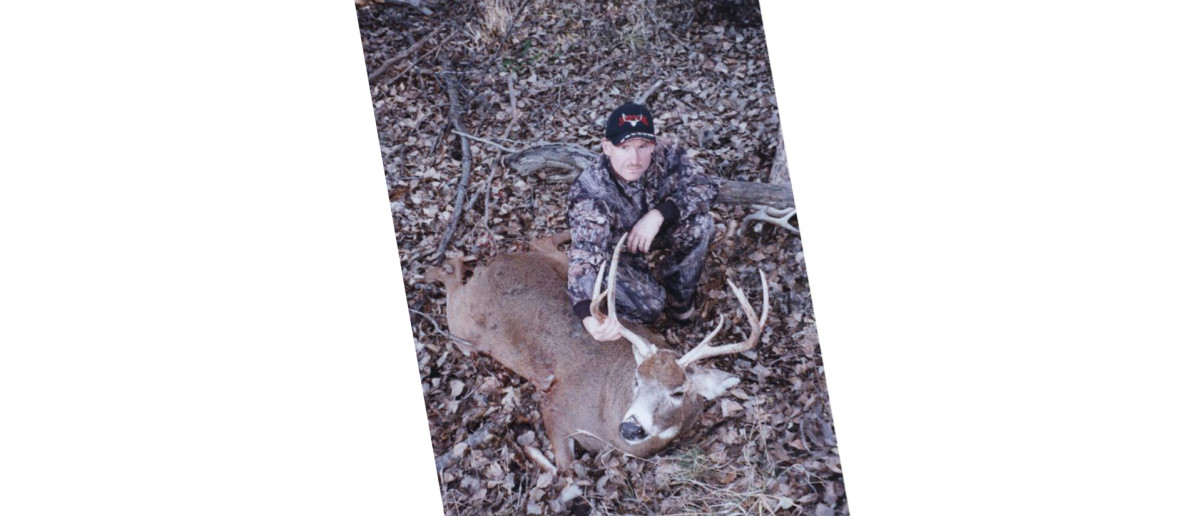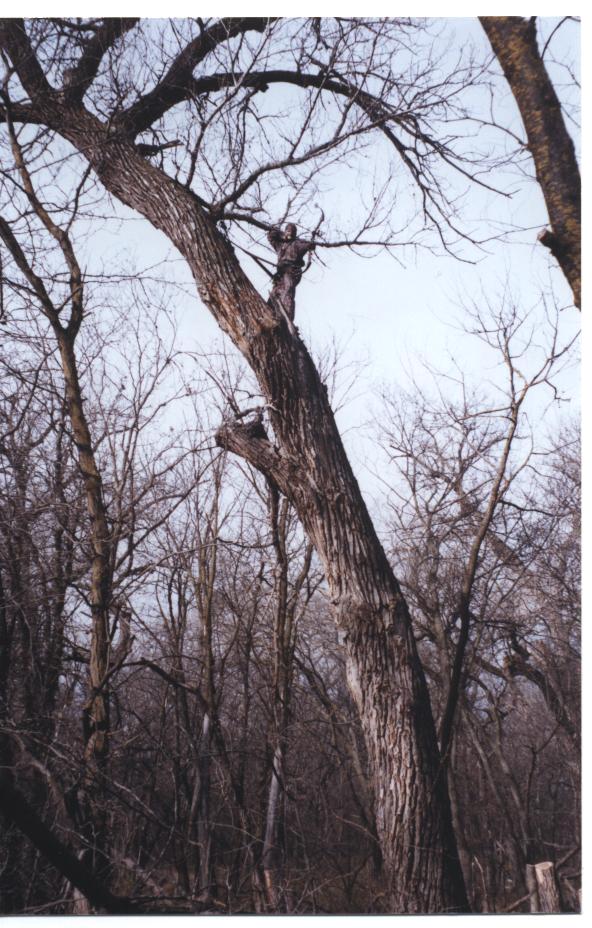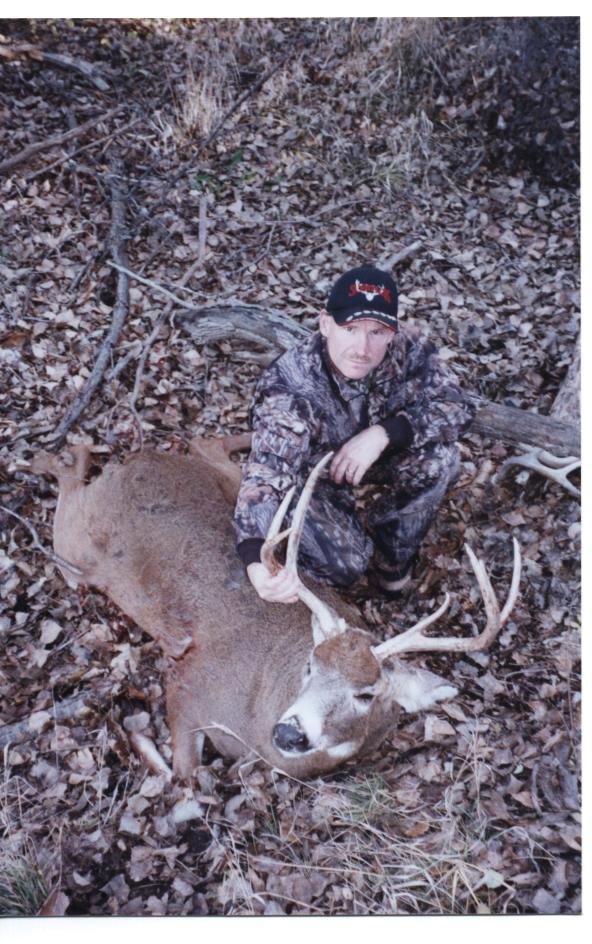
If you enjoyed Episodes #62 and #159 of the Wired To Hunt Podcast with John Eberhart, you’re in for a treat. Over recent months, we’ve been sharing a number of John’s successful kill stories and today we’re back with another. John’s detailed description of his hunts and plans offer a rare chance to get into the mind of one of the most seasoned and successful DIY bowhunters in the country. Take this opportunity to really process what he does and why he does it. Enjoy. – MK
By John Eberhart
2004 had been a very good year in Michigan as I’d taken an eight point on public land from the ground and then took a huge ten point just prior to the gun season. Now for the first time I was going to hit two states to continue bowhunting.
My plan was to go to Missouri alone for a week and then meet up with good friend Bryan for what would be his and my first ever bowhunt in Kansas. To say I was geeked would be an understatement.
I took a monster ten point in Missouri on a 40 acre parcel I had just received permission on and that hunt would be the most gut wrenching week of hunting I’d ever encountered due to the steady rain all week.
The Hunt Begins
It was the last week in November when I met up with Bryan in Kansas. We spent the first full day scouting and preparing locations on the original property I had acquired permission on and the next day and a half hunting them with not only no success, but also few deer sightings. The property owner and his friends had been bird hunting with dogs nearly every day prior to us arriving and had pretty much run all the deer off the 900 acre parcel specifically designed for pheasant hunting.
After our morning hunt on the third day we went looking for other properties to hunt. Lunch at the local tavern and blabbing to every farmer in it took care of our dilemma. After acquiring permission to hunt several thousand acres from several of the locals in the bar we immediately went back to work scouting.
It was post rut and while we found many inactive scrapes, we found only one active primary scrape area and it was located in a small woodlot east of a house that had been abandoned many years ago. There was a weed field to the south of the woodlot, a green field to the north, and more timber to the east.
This area of the state had went through a drought for nearly 10 years causing many property owners to just up and leave, because the property at the time was nearly worthless and they couldn’t sell it. Farming and raising cattle during that period was difficult and it was an eye opener to see so many old beautiful homes that were just abandoned and left in trusts.
The Set-Up
At the active scrape area there was only one tree big enough to hunt from in which all the scrapes were within shooting distance and it was a huge cottonwood. The cottonwood had about a 15 degree lean to it, had more than a 3 foot diameter, and the bark was about an inch and a half deep. To make things worse it was totally surrounded by six inch diameter 30 to 40 foot tall trees.
According to Bryan it would be physically impossible to get any type of conventional hang-on stand or climbing sticks in the huge cottonwood and he also only brought conventional rod steps which also wouldn’t work because the depth of the thick bark made it impossible for the threads of the steps to get deep enough into the meat of the tree to be safe enough to climb.
The problems that the cottonwood posed made our decision of which one of us would get to hunt there very easy, because I hunt from a sling I was the only one that could. After cutting 14 large trees down and cutting them into moveable pieces, we piled them up beneath the leaning side of the tree as if making a brush pile for rabbit habitat.
As I made my way up the tree screwing my Cranford folding steps between the bark and then folding the step down into the crease of the bark, Bryan continued to trim some small stuff in the shooting lanes. At about 30 plus feet, I screwed in seven steps around the perimeter of the tree to stand on and move around the tree on if needed for other shot opportunities away from the scrapes.
Bryan could not believe that there was anyway I would ever get a shot opportunity at a good buck after we basically raped the immediate area of so much cover and didn’t use any scent control when doing so. I told Bryan that this was Kansas and it received less pressure than Iowa and I knew from hunting in Iowa several times that mature bucks in lightly pressured areas don’t react anything similar whatsoever, to what they do at home and that the scrapes would likely continue to get visited during daylight no matter our total invasive intrusion.
I hunted elsewhere that evening and the next morning was in the cottonwood overlooking the primary scrape area and cut timber. It was an all-day hunt and I saw four different bucks in the evening but they were all small and were passed on.
The Final Hunt
The next morning about a half mile before getting to my hunting location a big ten point chased a doe across the road right in front of my mini-van. I had to stop the vehicle to keep from hitting him and unfortunately they were going away from my hunting spot. But it was two hours prior to first light and with the sparse available cover in the area a half mile is actually pretty close.
Sitting in the big cottonwood waiting for daybreak, my excitement level about the possibility of seeing the big 10 point was high. As it cracked dawn I reached for my rattle bag and made a 20 second aggressive rattle sequence. The morning was crisp with no wind and hopefully the big buck had moved to within hearing distance.
It wasn’t two minutes before a good buck was coming directly at me from the north, and when he got right below my tree he stopped. It was still very low light conditions and I was looking directly down at the bucks rack. The size and shape of the bucks frame looked like the 10 point, about 18 inches wide with long beams.
If a shot opportunity were presented, I decided to take it and I never looked at the antlers again. He moved away from the tree towards the scrapes and stopped at the first one offering me an 18 yard shot. I drew my Mathews Conquest bow and released the Carbon Express arrow, but wasn’t able to see where it hit. Being unfamiliar with the area I was concerned that if he had been hit too far back into the liver or paunch that I might possibly jump him and push him onto property in which I did not have permission so I decided to wait a while. I got down and waited a while before going to get Bryan to help look and hopefully drag.
We returned about midday and it only took a few minutes to recover him as my arrow passed through both lungs and he didn’t go over 100 yards. I was shocked as his rack was big but only had 6 points. Unfortunately the coyotes in the area found him first and had breakfast at my expense consuming most of his hind quarters from underneath. I’m sure we spooked the dogs off the carcass when we arrived.
This was the second time coyotes got to a deer before me, but the first time the buck was left overnight and this was during midday. Nature has its way of doing things that are out of our control.
This hunt was an excellent example of how aggressive a hunter can get when in a lightly hunted state or area. Deer in such areas simply don’t react to sudden dramatic changes to their environment and they are easily fooled by fake tactics and I can only assume that’s why most TV shows and videos are filmed in such easy to kill areas and not in heavily pressured areas where mature bucks seemingly have PhD’s at avoiding hunters.
Editors note: John Eberhart is an accomplished bow-hunter that specializes in heavily pressured areas with 29 bucks listed in CBM’s record book from 19 different properties in 10 different counties. John produced a 3 volume instructional DVD series titled “Bowhunting Pressured Whitetails” and co-authored the books, “Bowhunting Pressured Whitetails”, “Precision Bowhunting”, and “Bowhunting Whitetails the Eberhart Way”. They are available at www.deer-john.net, where you’ll also find information about his new whitetail workshops.





